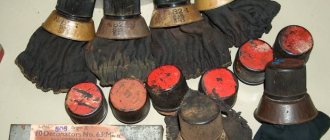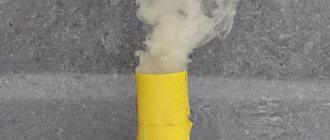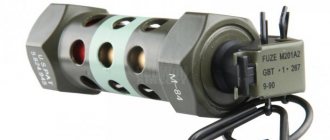RGD-5 grenade
Ever since the first people picked up sticks and stones, there has been a desire to throw something deadly at the enemy. The history of modern grenades began with the invention of gunpowder: the first remote bombs began to be thrown at enemy forces in close combat. The design was primitive: a simple vessel filled with an explosive mixture and a wick.
Such an imperfect device could cripple not only the enemy, but also the thrower himself. Development accelerated during the First World War. The characteristics and qualities inherent in modern grenades, such as F-1 and RGD-5, were achieved.
Modern hand grenades
There are many utility and anti-personnel projectiles available today. They solve a wide range of problems: from dispersing rallies using gas and noise suppression agents, to disabling military equipment and manpower of the enemy.
These “pocket” bombs are lightweight, versatile, and do not require additional equipment or any serious skills to use.
If we talk about destroying the enemy in close combat, then there are two types of grenades: defensive and offensive. Previously, there were also anti-tank ones, but with the development of rocket-propelled grenade launchers, the need for them completely disappeared.
At the same time, in order to destroy a tank, you had to get very close to the combat vehicle, and not all heroes succeeded in this.
Nowadays, every soldier on the battlefield carries several anti-personnel shells with him. In our army and the armies of the CIS countries, mainly two types of these weapons were and are currently used:
- Adopted in 1940 F-1.
- RGD-5, which entered service in 1954.
Over the course of half a century, there have been many military conflicts where these Soviet grenades have proven themselves to be effective, reliable and simple weapons. In the near future, no one will dare remove them from service.
Later, in the 70s, RGN (offensive hand grenade) and RGO (defensive hand grenade) were developed. Structurally, they are very different from their descendants, but the characteristics are approximately the same. The main differences are that the fuses have an impact sensor on any surface (except dirt or snow), which leads to detonation of the weapon. The RGN has a smooth round body with an internal notch and a plastic fuse.
The lethal radius of the fragments is 8.7 meters from the epicenter of the explosion.
To increase the number of fragments there is also an internal housing with notches. RGO also has a round steel body with four hemispheres, i.e. 2 internal and 2 external. The radius of scattering fragments is 150 meters, and the lethal radius is 16-17 meters.
RGD-5 grenade
The F-1 defensive grenade has a radius (200 meters) of scattering fragments greater than the length of the thrower's throw (40-50 meters). Accordingly, it can only be used from cover or from an armored personnel carrier, so as not to fall under stray shrapnel.
The RGD-5 offensive grenade is used during an attack, when it is necessary not to “catch” advancing comrades and yourself with fragments. With an average throwing range of a grenade of 45 meters, the radius of scattering of fragments is 25-35 meters, and the radius of destruction is about 5 meters. You can throw the RGD from an open area without fear of being wounded by shrapnel.
Description of the combat grenade
| Explosion speed | 0.5 - 1.5 seconds |
| Scattering of fragments | 15-25 meters |
| Radius of continuous damage | 5 meters |
| Fuse | remote 3.2-4.2 seconds, UZRG |
| Weight of explosives | 110 grams, TNT |
| Weight | 310 grams |
| Dimensions | 117x58mm |
RGD-5
offensive grenade The RGD-5 offensive grenade replaced the RG-42, and also as a lighter and less powerful alternative to the F-1 grenade. Moreover, the use of the RGD-5 grenade is recommended not only during military operations, armed conflicts or similar incidents, but also as a training grenade.
The use of the RGD-5 for training purposes, as a rule, is justified by the fact that it does not have such powerful destructive power and range than, for example, the F-1.
The grenade was adopted by the USSR and is used by Russian troops to this day. It is also worth noting that the RGD-5 is in service in many countries around the world, and some produce copies of it. For example, in China, under a purchased license, the TIP-59 grenade is produced, which exactly copies the RGD-5.
See also the article Grenade F-1 and its history
Components of RGD-5 (remote hand grenade)
The gun has an oval body made of two smooth hemispheres, stamped from tin or thin steel. The body itself acts as the damaging elements, without additional filling with shrapnel.
Fuse UZRG, UZRGM (modernized unified hand grenade fuse) or UZRGM-2. The fuse consists of a safety lever, a safety pin, and the firing mechanism itself, including a spring, a primer and a detonator.
All this is built into a metal fuse tube.
RGD-5 grenade with fuse
The explosive filler in the grenade is 110 grams of TNT.
Operating principle of RGD-5
The antennae of the pins are bent in such a way as to prevent an arbitrary explosion. After straightening the antennae, you need to apply force to pull out the pin ring. The pin is held by the safety lever, and after it is pulled out, the lever is held by the hand of the grenade thrower, pressing it to the body.
The lever holds the striking mechanism. After the hand releases the lever, the firing pin, under the influence of a straightened spring, rushes into the igniter capsule.
RGD-5 grenades
The kinetic energy of the impact ignites the powder retarder charge. The moderator burns for a few seconds and ignites the detonator cap. The detonator detonates the main TNT charge. The released energy tears the body into a hundred fragments and creates a shock wave.
A smooth body without notches leads to completely random shapes of fragments and the direction of their scattering.
Penetration ability decreases in proportion to increasing distance.
The defeat of the enemy depends on many factors. The destruction of an enemy that is directly close to the epicenter is not guaranteed. And a fragment at the end of its life can, perhaps, slightly hit a fighter.
Sweet pomegranate varieties
Among the many varieties, several varieties of pomegranate with a high sugar content stand out. These types are best consumed fresh.
Important! The fruits acquire a sweet taste only when fully ripe.
Bala-mursal
Azerbaijani variety, characterized by excellent taste. The pomegranate tree reaches a height of 3 m. The fruits are large, each weighing 400-500 g. The peel is thick, and when ripe it acquires a dark crimson color.
The grains are fleshy, juicy, large. Medium sized bones. The juice based on this variety of red pomegranate has a pleasant taste, sweet and sour. Fruit sugar content is 17%, acid content is up to 1.5%. Ripening is friendly, in early October. The variety is cultivated in Azerbaijan.
Bala-mursal pomegranate fruits can be stored for up to four months without loss of presentation
Nar-Shirin
Iran is considered the birthplace of the variety. When the fruit ripens, the peel remains pink-beige with green spots. The grains are characterized by a perfectly round shape. Their color ranges from pale to deep pink.
Nar-Shirin is considered one of the sweetest varieties of pomegranate. Sugar content is about 18%, acid level is 1.4%.
In terms of commercial qualities, Nar-Shirin fruits are inferior to other types
Bedana
Indian variety of pomegranate. Produces medium-sized fruits. The culture is distinguished by tall bushes with a luxurious crown. Prefers to grow in regions with hot, dry climates in summer and cool winters.
Bedana pomegranate does not tolerate transportation well
Ahmar
A bush variety of pomegranate, the birthplace of which is Iran. The plant reaches a height of 4 m. The flowering period begins in May and continues until the end of summer.
When ripe, the fruits are pink with a green tint. The grains are juicy and sweet. Sugar content – 16%, acid – does not exceed 1.5%.
The grains of the Ahmar pomegranate are light pink in color, but very sweet
Dholka
The plant is wild and grows in India. This variety of pomegranate is considered the sweetest in the world. The peel of the fruit is light in color with a pink blush. Dholka pomegranates are small in size and weigh about 180-220 g. The shade of the grains can vary from white to light pink. In its natural habitat, the height of the plant does not exceed 2 m.
The roots of the Dholka pomegranate are used to prepare a healing remedy for bruises and fractures, and the decoction helps with dysentery
Frost-resistant pomegranate varieties
Pomegranate, despite such a huge variety of varieties, still remains a purely heat-loving crop. But thanks to the efforts of breeders, some species have acquired an average level of frost resistance, and are able to withstand short-term drops in temperature down to -15 degrees. However, this is not enough to survive a long cold period.
Even for frost-resistant pomegranate varieties, reducing the temperature to -17 degrees is critical. In this case, first the entire above-ground part of the plant freezes up to the root collar, and then the roots die.
Pomegranate varieties with an average level of frost resistance:
- Gyuleysha red;
- Ak-Dona;
- Gyuleisha pink;
- Nikitsky early.
Important! A pomegranate tree, when covered for the winter, is able to survive in regions with harsh climates, but at the same time it will not be able to fully bloom and produce a harvest.
Where to wear
Grenades are transported in a wooden box of 20 pieces separately from the fuses. During transportation, instead of a fuse, a plastic or ebonite plug is screwed in to protect the tube from dirt and foreign objects.
The fuses are screwed in immediately before a fight or before a throw.
For individual carrying of grenades, grenade pouches, unloading or special pockets are provided.
Fuses are carried in paper or plastic wrap until used.
How to throw RGD-5
Take it in your free hand and press the safety lever firmly against the body. With your other hand, unclench the antennae of the pins, insert your finger into the ring and pull it out. You can quit right away, or you can wait for the right moment.
To wait for the moment, you need to keep the bracket pressed to the grenade. In this position, the striking mechanism is held by a lever and you can walk like this indefinitely.
If you suddenly don’t want to throw a cocked projectile, the pin is inserted back through the fuse hole and the safety bracket ears. After releasing the lever, the percussion mechanism on the primer will fire with a loud bang. There are 3-4 seconds left before the explosion.
An experienced and strong soldier is able to throw a grenade at least 50 meters. You need to throw at an angle of 30-45 degrees.
RGD-5 grenades
There should be no obstacles in the flight path such as wires, tree branches or tall grass.
When throwing into rooms through door and window openings, you need to be very careful and have the opportunity to take cover yourself.
If the throw is unsuccessful, the grenade may bounce back off the wall.
Accordingly, the sequence of application:
- Unscrew the plug and screw in the fuse (if not prepared for battle earlier).
- With your free hand, part the antennae of the checks.
- Place your index finger through the ring and pull it out.
- After waiting for the right moment, throw it at the target.
It is not recommended to approach unexploded shells. It is prohibited to deactivate explosive objects (explosive objects) without special knowledge and experience.
What are the types of pomegranate fruit?
All existing plant varieties are divided into two main categories. The first is characterized by tough, hard seeds inside the fruit. These species grow in the southern regions, where climatic conditions correspond to this crop. They are undemanding in terms of soil composition and care, so there are no difficulties in growing them.
Another category includes types of pomegranate with soft seeds, which are practically not felt when eating the grains. These species do not grow everywhere, as they are more capricious and require increased attention. Such varieties need to maintain the level of humidity and air temperature, and they also prefer a certain soil composition.
How many varieties of pomegranate are there?
More than five hundred cultivated varieties of pomegranate are known, and thanks to the efforts of breeders, their number increases every year. The goal is to breed species with increased resistance to diseases and low temperatures.
On the territory of the reserve in the village. Kara-Kala, which is located in Turkmenistan, has the largest collection of pomegranates. About 800 different types of crops grow here.
What varieties of pomegranate are there?
There are several types of pomegranate, from which all other hybrid forms were derived. Each of them differs not only in the size and color of the fruit, but also in the color of the grains, as well as other characteristics. Therefore, to understand the difference between them, it is necessary to consider some varieties separately.
Ordinary
This species is a deciduous tree, the height of which can reach 10 m. The plant has a highly branched trunk, angular shoots and a wide crown. The leaves of the common pomegranate are oval, leathery, and light green in color. They are located opposite on the shoots and are attached using short petioles. The length of the plates is about 6 cm.
The flowers are bell-shaped, red-orange in color, and can be single or double. Their diameter does not exceed 5 cm. The fruits of the ordinary pomegranate are spherical in shape and red or red-brown in color. Their size is 10-12 cm. The grains are juicy, large, and coarse.
Important! An ordinary pomegranate seedling begins to bear fruit at 3-4 years.
The flowering period is from spring to autumn, the fruits ripen in August-October. The growing season is 180-210 days. The lifespan of this variety is 50-60 years.
The ordinary pomegranate has a high yield; up to 60 kg of fruit can be obtained from one adult plant.
Yellow
This fruit can grow as a shrub or tree. Its height does not exceed 5 m. The skeletal branches of the plant are covered with small thorns. Thin shoots with light brown bark are attached to them.
The leaves of the yellow pomegranate variety are oblong-rounded, reaching a length of 8 cm and a width of 2-3 cm. They are located opposite on the shoots. The plates have a glossy surface. The leaves are attached with short petioles and collected in bunches.
Yellow pomegranate flowers have a red-orange hue. They are enclosed in inflorescences of 2-5 pieces. The fruits of the variety are large, their diameter can reach 17 cm. A distinctive feature is the color of the peel - yellow-olive. The grains are juicy, fleshy, sweet, pale pink in color.
Yellow pomegranate fruits are often mistaken for unripe due to the unusual color of the peel.
Soqotran
This variety is considered the predecessor of the common pomegranate. It is found naturally on the island of Socotra. Prefers limestone and rocky soils.
Socotrans pomegranate is an evergreen plant, no more than 4.5 m high. The leaves are oval, leathery with short petioles. The flowers are bell-shaped, pink in color, slightly raised on the peduncle.
The fruits are characterized by a dense peel, the shade of which can vary from scarlet to yellowish-orange. Their diameter does not exceed 10 cm. The grains have a sweet and sour taste.
Socotran pomegranate is not cultivated
URG-N (training offensive hand grenade)
Made on the basis of RGD-5. Designed for practicing grenade throwing skills. Combat and training copies have practically no differences in appearance; they have the same weight and handling technique. The explosion is simulated by the clap of the fuse and smoke.
To enhance the sound of the clap, a hole was made in the training grenade.
This “blank” weapon is used repeatedly.
The model of the training grenade is painted black and also has a special white “Training” marking.
The best varieties of pomegranate
Among the wide variety of pomegranate varieties, some can be distinguished that are significantly superior to others in terms of characteristics. Some of them are undemanding to care, but at the same time maintain high productivity. Others are compact in size, so they can be grown at home. And still others are characterized by high taste qualities.
Baby
A low-growing bush variety of pomegranate, the height of which does not exceed 0.5 m. Its homeland is considered to be the Mediterranean and Asia. Produces small yellow-orange fruits.
Important! The Baby variety has high decorative qualities, so it can be kept as a houseplant.
Flowering is abundant from April to September. It makes no sense to grow for the sake of fruits, since the percentage of ovaries is small. The leaves have a glossy surface and are collected in bunches. The branches are strewn with small thorns.
The Baby pomegranate variety requires annual pruning of the bush to preserve its decorative qualities.
Mangulati Sweet
An Israeli variety of pomegranate, the height reaches 5 m. The species is characterized by the average size of the fruits, the weight of which is 180-210 g. The grains are juicy, sweet and sour, with a pleasant taste.
Fruit seeds are used in the production of cosmetics, as they have an antioxidant effect. Based on them, an oil is prepared that saturates the skin with collagen, which allows you to restore lost turgor.
Based on this variety, several hybrid forms of pomegranate were bred, the weight of the fruits reaching 400 g
Carthage
Another dwarf type of pomegranate, the height of which does not exceed 1 m. It has a long flowering period, so it can be grown as a decorative houseplant. The leaves of the Carthage variety are oblong and light green in color.
Flower colors can be yellow, white and red-orange, but the latter is the most common.
Important! Carthage is characterized by small fruits that have no nutritional value, so the plant should be grown as an ornamental.
In the absence of pruning, the shoots of Carthage become thinner and have an unsightly appearance.
Achikanor
The variety is distinguished by round fruits of light carmine color. The peel is thin. The grains are juicy, fleshy, dark red in color. The taste is pleasant, sweet and sour with a slight tartness. The weight of each fruit is about 300 g.
The pomegranate tree of this variety reaches 4-5 m in height. When growing, it is recommended to leave 4-5 skeletal branches.
Juice based on Achikanor perfectly quenches thirst
Dogwood anor
Uzbek large-fruited variety, which is a variety of red pomegranates. The average weight of the fruit is 400 g. The rind is yellowish with a green tint, of medium thickness. The grains of Kizil-anor are dark red, rich in color, and large. The juice obtained from this variety tastes sweet and sour. Sugar content of Kizil-anor is 15%, acid content is no more than 1.85%. The fruits should be collected at the end of October.
Important! The yield is high - up to 60 kg per adult plant.
The pomegranate variety Kizil-anor has a juice yield of about 45%
Ak-Dona
This species belongs to the category of early ripening, so the harvest can be harvested in the second half of September. The peel has a yellowish tint with red splashes. The large fruits of the variety are slightly flattened on the sides. The grains are dark pink. Taste with pronounced sourness.
Leaf blades are 5-7 cm long, rich dark green in color. The tree does not exceed 4 m in height, but at the same time forms a wide crown. Harvesting should take place in the second half of October.
Ak-Don pomegranate is cultivated in the steppe of Crimea and in Central Asia
Gyuleysha pink
An Azerbaijani variety, the distinctive feature of which is rounded fruits with a pink tint to the peel. The grains become dark red when ripe and are medium in size.
The pomegranate tree reaches a height of 3 m. The crown is spreading, and there are small thorns on the shoots. The average weight of each fruit is 250 g.
Important! The fruit of the Gyuleysha rosea variety does not tolerate transportation well, so it is not imported.
The shelf life of fruits does not exceed four months
Gyuleysha red
Another Azerbaijani pomegranate variety, which is characterized by round fruits with a carmine-red tint to the peel. The average weight of each is 300-400 g.
The grains are large, juicy, fleshy. When ripe they turn dark red. Gyuleisha red pomegranates taste sweet and sour. Fruit sugar content is up to 16%, acidity is about 1.8%.
Guleisha red ripening occurs at the end of October, storage duration is about three months.
Nikitsky Early
This variety was bred in the Nikitsky Botanical Garden. A heat-loving species that requires shelter for the winter. Forms a medium-sized bush, the height of which does not exceed 2 m.
Important! Nikitsky early is distinguished by long-term flowering and produces male and female flowers.
The fruits are large, the peel is of medium thickness. Pomegranates taste sweet with slight sourness.
Nikitsky early is in many ways similar in characteristics to the ordinary type of culture
Achik-anar
This variety of pomegranate is cultivated in Uzbekistan and Tajikistan. It is distinguished by large fruits, the weight of which reaches 300-400 g. The sugar content of the grains is 16%, the acidity level does not exceed 1.4%. Harvesting should take place in mid-October.
The fruit of this variety easily tolerates transportation and is stored well. It is distinguished by high commercial qualities. The taste of the grains is sweet, but not cloying.
The yield of Achik-anar pomegranate is 40-50 kg per plant








